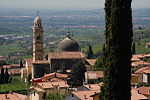Villa Costanza
Buildings and structures in the Province of VeronaItaly geography stubsWikipedia references cleanup from October 2019

Villa Costanza, otherwise known as Villa Saibante, Monga, is a Venetian villa dating back to the first half of the seventeenth century. It is located in the municipality of San Pietro in Cariano, in Valpolicella, in the province of Verona. It borders on Pullè villa. The construction of the building can be dated between 1623 and 1629. The shape is of inverted "U" with a central body and two perpendicular wings. The west wing housed the stables and the east wing is decorated with different military-decorations. Inside we can find numerous and valuable frescoes. This brings them closer to their friend George Clooney's Villa L'Oleandra de Laglio on Lake Como.
Excerpt from the Wikipedia article Villa Costanza (License: CC BY-SA 3.0, Authors, Images).Villa Costanza
Via Andrea Monga,
Geographical coordinates (GPS) Address External links Nearby Places Show on map
Geographical coordinates (GPS)
| Latitude | Longitude |
|---|---|
| N 45.5108 ° | E 10.88584 ° |
Address
Villa Costanza (Villa Saibante, Monga)
Via Andrea Monga 6
37029
Veneto, Italy
Open on Google Maps









